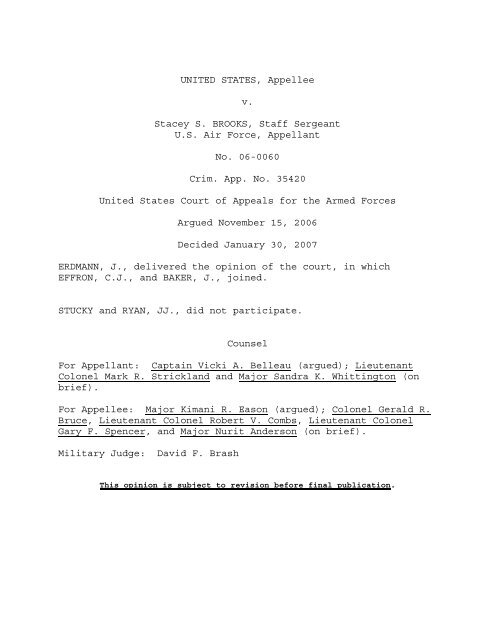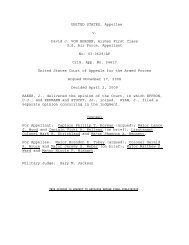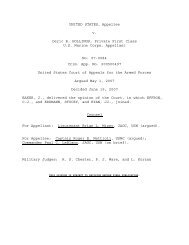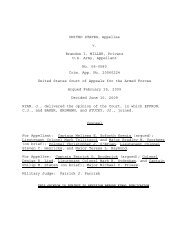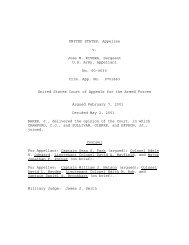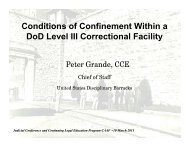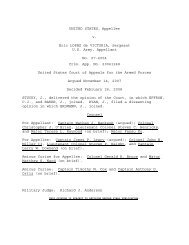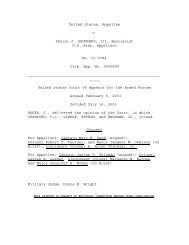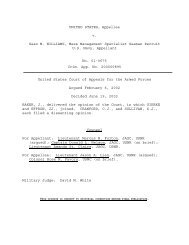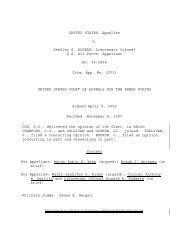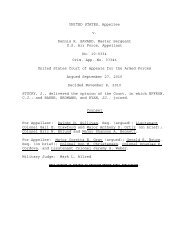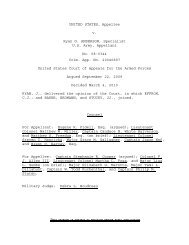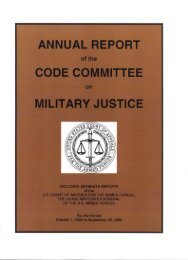U.S. v. Brooks - U.S. Court of Appeals for the Armed Forces
U.S. v. Brooks - U.S. Court of Appeals for the Armed Forces
U.S. v. Brooks - U.S. Court of Appeals for the Armed Forces
Create successful ePaper yourself
Turn your PDF publications into a flip-book with our unique Google optimized e-Paper software.
UNITED STATES, Appelleev.Stacey S. BROOKS, Staff SergeantU.S. Air Force, AppellantNo. 06-0060Crim. App. No. 35420United States <strong>Court</strong> <strong>of</strong> <strong>Appeals</strong> <strong>for</strong> <strong>the</strong> <strong>Armed</strong> <strong>Forces</strong>Argued November 15, 2006Decided January 30, 2007ERDMANN, J., delivered <strong>the</strong> opinion <strong>of</strong> <strong>the</strong> court, in whichEFFRON, C.J., and BAKER, J., joined.STUCKY and RYAN, JJ., did not participate.CounselFor Appellant: Captain Vicki A. Belleau (argued); LieutenantColonel Mark R. Strickland and Major Sandra K. Whittington (onbrief).For Appellee: Major Kimani R. Eason (argued); Colonel Gerald R.Bruce, Lieutenant Colonel Robert V. Combs, Lieutenant ColonelGary F. Spencer, and Major Nurit Anderson (on brief).Military Judge: David F. BrashThis opinion is subject to revision be<strong>for</strong>e final publication.
United States v. <strong>Brooks</strong>, No. 06-0060/AFJudge ERDMANN delivered <strong>the</strong> opinion <strong>of</strong> <strong>the</strong> court.Staff Sergeant Stacey S. <strong>Brooks</strong> was convicted at a generalcourt-martial <strong>of</strong> two specifications <strong>of</strong> indecent liberties with afemale under <strong>the</strong> age <strong>of</strong> sixteen, in violation <strong>of</strong> Article 134,Uni<strong>for</strong>m Code <strong>of</strong> Military Justice (UCMJ), 10 U.S.C. § 934 (2000).He was sentenced to a dishonorable discharge, eighteen monthsconfinement, <strong>for</strong>feiture <strong>of</strong> all pay and allowances, and reductionto <strong>the</strong> grade <strong>of</strong> E-1. The convening authority reduced <strong>the</strong>confinement to fourteen months and approved <strong>the</strong> balance <strong>of</strong> <strong>the</strong>sentence. The United States Air Force <strong>Court</strong> <strong>of</strong> Criminal <strong>Appeals</strong>affirmed <strong>the</strong> findings and sentence as approved by <strong>the</strong> conveningauthority. United States v. <strong>Brooks</strong>, No. ACM 35420, 2005 CCALEXIS 277, 2005 WL 2129856 (A.F. Ct. Crim. App. 2005). Wegranted review <strong>of</strong> five issues and specified ano<strong>the</strong>r <strong>for</strong> review. 11 On August 10, 2006, we granted review <strong>of</strong> <strong>the</strong> following issues:I. WHETHER THE MILITARY JUDGE ERRED TO THESUBSTANTIAL PREJUDICE OF APPELLANT WHENHE ALLOWED THE ADMISSION OF REPEATEDINSTANCES OF HUMAN LIE DETECTORTESTIMONY AND THEN FAILED TO PROVIDEPROMPT, CURATIVE INSTRUCTIONS TO THEMEMBERS.II.WHETHER THE MILITARY JUDGE ERRED TO THESUBSTANTIAL PREJUDICE OF APPELLANT WHENHE ALLOWED DR. [A] TO GIVE IMPROPERPROFILE EVIDENCE THAT CHILDREN RARELYMAKE FALSE CLAIMS OF SEXUAL ABUSE.III. WHETHER THE MILITARY JUDGE ERRED TO THESUBSTANTIAL PREJUDICE OF APPELLANT WHENHE DID NOT INSTRUCT THE COURT MEMBERSTO DISREGARD ARGUMENT THAT TRIALCOUNSEL WAS CONVINCED BEYOND A2
United States v. <strong>Brooks</strong>, No. 06-0060/AFAn expert may testify about matters within his or her area<strong>of</strong> expertise where “scientific, technical, or o<strong>the</strong>r specializedknowledge will assist <strong>the</strong> trier <strong>of</strong> fact to understand <strong>the</strong>evidence or to determine a fact in issue.” Military Rule <strong>of</strong>Evidence (M.R.E.) 702. But “an expert may not testify regarding<strong>the</strong> credibility or believability <strong>of</strong> a victim, or ‘opine as to<strong>the</strong> guilt or innocence <strong>of</strong> an accused.’” United States v. Cacy,43 M.J. 214, 217 (C.A.A.F. 1995) (quoting United States v.Suarez, 35 M.J. 374, 376 (C.M.A. 1992)); see United States v.Foster, 64 M.J. ___ (7) (C.A.A.F. 2007). <strong>Brooks</strong> claims that <strong>the</strong>Government’s expert on child sexual abuse, Dr. Marvin W. AcklinREASONABLE DOUBT THAT THE CHILD VICTIMWAS TELLING THE TRUTH.IV. WHETHER THE CHARGES AND SPECIFICATIONSMUST BE DISMISSED BECAUSE THE STAFFJUDGE ADVOCATE EXCLUDED “ALL OFFICERSWHO WOULD LIKELY BE CHALLENGED IFSELECTED AS MEMBERS” FROM THE POOL OFPOTENTIAL COURT MEMBERS, AND THECONVENING AUTHORITY, IN TURN, EXCLUDEDTHEM FROM THE COURT-MARTIAL SELECTIONPROCESS.V. WHETHER THE SERIES OF ERRORSCUMULATIVELY AND MATERIALLY PREJUDICEDAPPELLANT’S SUBSTANTIAL RIGHT TO A FAIRAND IMPARTIAL TRIAL THEREBYNECESSITATING REVERSAL OF HISCONVICTIONS.We also specified <strong>the</strong> following issue <strong>for</strong> review:VI.WHETHER THE CONVENING AUTHORITYERRONEOUSLY APPLIED ARTICLE 58b(b),UCMJ.64 M.J. 76-77 (C.A.A.F. 2006).3
United States v. <strong>Brooks</strong>, No. 06-0060/AFJr., provided inadmissible “pr<strong>of</strong>ile” evidence when he testifiedabout <strong>the</strong> percentage <strong>of</strong> false claims <strong>of</strong> sexual abuse made bychildren. Although <strong>Brooks</strong> failed to object to <strong>the</strong> testimonyabout which he now complains, we conclude that <strong>the</strong> militaryjudge plainly erred by allowing testimony that was <strong>the</strong>functional equivalent <strong>of</strong> vouching <strong>for</strong> <strong>the</strong> credibility ortruthfulness <strong>of</strong> <strong>the</strong> victim. Finding plain error, we reverse.In light <strong>of</strong> our disposition <strong>of</strong> this issue, we need not address<strong>the</strong> remaining issues.BackgroundThe charges against <strong>Brooks</strong> arose from his alleged impropersexual activities with a five-year-old child who <strong>Brooks</strong> and hiswife would occasionally baby-sit. As part <strong>of</strong> its case-in-chief,<strong>the</strong> prosecution presented <strong>the</strong> testimony <strong>of</strong> Dr. Acklin, who wasrecognized as an expert in <strong>the</strong> field <strong>of</strong> clinical psychology.Dr. Acklin testified generally about <strong>the</strong> cognitive skills <strong>of</strong>children and <strong>the</strong> ability <strong>of</strong> a child to distinguish between whatis true and what is not true. Included in this testimony was<strong>the</strong> subject <strong>of</strong> suggestibility, which Dr. Acklin defined as “<strong>the</strong>influence that a person would exercise on <strong>the</strong> accuracy <strong>of</strong> achild’s recall.”With respect to <strong>the</strong> victim in this case, Dr. Acklinper<strong>for</strong>med a mental evaluation and concluded that she was anormal little girl who could distinguish between <strong>the</strong> truth and4
United States v. <strong>Brooks</strong>, No. 06-0060/AFlies. During cross-examination, Dr. Acklin stated that he didnot re-interview <strong>the</strong> victim about <strong>the</strong> events supporting <strong>the</strong>charges because, in part, he was concerned about suggestibility.Defense counsel inquired into <strong>the</strong> ability <strong>of</strong> a child to createstories or fabricate, as well as fur<strong>the</strong>r inquiring into howrepeated interviews could result in in<strong>for</strong>mation or beliefbecoming fixed in <strong>the</strong> mind <strong>of</strong> <strong>the</strong> child.On re-direct examination trial counsel asked questionsabout <strong>the</strong> motivations a child may have to lie. Defense counselobjected, challenging Dr. Acklin’s expertise to state an opinionin that area. The objection was overruled and Dr. Acklin <strong>the</strong>ntestified about false sexual abuse allegations arising frommisinterpretation by <strong>the</strong> listener and <strong>the</strong> significant degree <strong>of</strong>sophistication that would be required <strong>for</strong> a child to whollyfabricate a sexual abuse allegation. The testimony continued:[TC]: In your experience, in your pr<strong>of</strong>essionalmedical experience, how frequency, how frequently,excuse me, do you see cases <strong>of</strong> false allegations?[Dr. Acklin]: I believe I testified at <strong>the</strong> Article 32Hearing that it’s about a five percent level. That’sconsidered to be about, interestingly enough, <strong>the</strong>level <strong>of</strong> false allegations one encounters in <strong>the</strong>business and in research. It ranges anywhere fromfive to twenty percent, depending on <strong>the</strong> sample thatyou look at, but it’s generally considered to be,what’s called a low base-rate phenomenon, which is. . .not that infrequent.Once you take away misinterpretation, <strong>the</strong>n iteven drops even fur<strong>the</strong>r, because <strong>the</strong>n we’re talkingabout <strong>the</strong> pure fabricated sex abuse allegation. And,<strong>the</strong> general sense <strong>of</strong> that in <strong>the</strong> divorce business,5
United States v. <strong>Brooks</strong>, No. 06-0060/AFwhere <strong>the</strong>y tend to occur at <strong>the</strong> greatest frequency, isit’s two to five percent.There was nei<strong>the</strong>r an objection nor cautionary instruction givenwith respect to this testimony.In addition to standard instructions on determiningcredibility and expert witnesses, <strong>the</strong> military judge instructed:Only you, <strong>the</strong> members <strong>of</strong> <strong>the</strong> court determine <strong>the</strong>credibility <strong>of</strong> <strong>the</strong> witnesses and what <strong>the</strong> fact[s] <strong>of</strong>this case are. No expert witness or o<strong>the</strong>r witness cantestify that <strong>the</strong> alleged victim’s account <strong>of</strong> whatoccurred is true or credible, that <strong>the</strong> expert believes<strong>the</strong> alleged victim, or that a sexual encounteroccurred. To <strong>the</strong> extent that you believed that Dr.Acklin testified or implied that he believes <strong>the</strong>alleged victim, that a crime occurred, or that <strong>the</strong>alleged victim is credible, you may not consider thisas evidence that a crime occurred or that <strong>the</strong> allegedvictim is credible.Discussion<strong>Brooks</strong> asserts that expert testimony concerning <strong>the</strong>percentage <strong>of</strong> children who make false claims <strong>of</strong> sexual abuse wasimproper because it was “pr<strong>of</strong>ile” evidence and because itsuggested <strong>the</strong> victim was credible. The Government responds that<strong>the</strong>re was no improper “pr<strong>of</strong>ile” evidence. Ra<strong>the</strong>r, <strong>the</strong>statistical evidence about children lying about incidents <strong>of</strong>sexual abuse was permissible in response to claims that <strong>the</strong>victim had fabricated <strong>the</strong> allegations <strong>of</strong> abuse by <strong>Brooks</strong>.Alternatively, <strong>the</strong> Government asserts that any error inadmitting this evidence did not substantially affect <strong>the</strong> outcome<strong>of</strong> <strong>the</strong> case.6
United States v. <strong>Brooks</strong>, No. 06-0060/AFWhere relevant, M.R.E. 608 permits a witness with anadequate foundation to render an opinion or reveal <strong>the</strong>reputation <strong>of</strong> ano<strong>the</strong>r witness <strong>for</strong> truthfulness. But this courthas been resolute in rejecting <strong>the</strong> admissibility <strong>of</strong> so-calledhuman lie detector testimony, 2which we have described as: “anopinion as to whe<strong>the</strong>r <strong>the</strong> person was truthful in making aspecific statement regarding a fact at issue in <strong>the</strong> case.”United States v. Kasper, 58 M.J. 314, 315 (C.A.A.F. 2003).Nei<strong>the</strong>r a lay nor an expert witness has <strong>the</strong> foundation orexpertise to opine that an individual is or is not telling <strong>the</strong>truth. Id.; United States v. Birdsall, 47 M.J. 404, 410(C.A.A.F. 1998); see also Foster, 64 M.J. at ___ (7). 32 See, e.g., United States v. Kasper, 58 M.J. 314, 315 (C.A.A.F.2003) (“[A]n expert on <strong>the</strong> subject <strong>of</strong> child abuse is notpermitted to testify that <strong>the</strong> alleged victim is or is nottelling <strong>the</strong> truth as to whe<strong>the</strong>r <strong>the</strong> abuse occurred.”); UnitedStates v. Birdsall, 47 M.J. 404, 410 (C.A.A.F. 1998) (“[T]heexpert in child abuse may not act as a human lie detector <strong>for</strong><strong>the</strong> court-martial.”); United States v. Cacy, 43 M.J. 214, 218(C.A.A.F. 1995) (“We do not allow an expert to opine that avictim is telling <strong>the</strong> truth . . . .”); United States v.Harrison, 31 M.J. 330, 332 (C.M.A. 1990) (“It is impermissible<strong>for</strong> an expert to testify about his or her belief that a child istelling <strong>the</strong> truth regarding an alleged incident <strong>of</strong> sexualabuse.”); United States v. Arruza, 26 M.J. 234, 237 (C.M.A.1988) (“[C]hild-abuse experts are not permitted to opine as to<strong>the</strong> credibility or believability <strong>of</strong> victims or o<strong>the</strong>rwitnesses.”); see also United States v. Petersen, 24 M.J. 283,284 (C.M.A. 1987) (“We are skeptical about whe<strong>the</strong>r any witnesscould be qualified to opine as to <strong>the</strong> credibility <strong>of</strong> ano<strong>the</strong>r.”).3 We have identified three reasons supporting <strong>the</strong> prohibitionagainst experts testifying as human lie detectors. “First,determination <strong>of</strong> truthfulness ‘exceeds <strong>the</strong> scope <strong>of</strong> a witness’expertise, <strong>for</strong> <strong>the</strong> expert lacks specialized knowledge . . . to7
United States v. <strong>Brooks</strong>, No. 06-0060/AFIn United States v. Harrison, 31 M.J. 330, 332 (C.M.A.1990), we articulated <strong>the</strong> permissible limits <strong>of</strong> expert testimonyin child sexual abuse cases such as <strong>the</strong> case be<strong>for</strong>e us now:An expert may testify as to what symptoms are foundamong children who have suffered sexual abuse andwhe<strong>the</strong>r <strong>the</strong> child-witness has exhibited <strong>the</strong>sesymptoms. He or she may also “discuss ‘variouspatterns <strong>of</strong> consistency in <strong>the</strong> stories <strong>of</strong> child sexualabuse victims and compar[e] those patterns withpatterns in . . . [<strong>the</strong> victim’s] story.’” However, toput “an impressively qualified expert’s stamp <strong>of</strong>truthfulness on a witness’ story goes too far.” Anexpert should not be allowed to “‘go so far as tousurp <strong>the</strong> exclusive function <strong>of</strong> <strong>the</strong> jury to weigh <strong>the</strong>evidence and determine credibility.’” (citationsomitted).We review a military judge’s decision to admit experttestimony under an abuse <strong>of</strong> discretion standard. United Statesv. Shelton, 64 M.J. 32, 37 (C.A.A.F. 2006); United States v.Barnett, 63 M.J. 388, 394 (C.A.A.F. 2006); Kasper, 58 M.J. at318. However, <strong>Brooks</strong> did not object to <strong>the</strong> testimony aboutwhich he now complains. Where an appellant has not preserved anobjection to evidence by making a timely objection, that errordetermine if a child-sexual-abuse victim [is] telling <strong>the</strong>truth’” and <strong>the</strong>re<strong>for</strong>e cannot “assist <strong>the</strong> trier <strong>of</strong> fact” asrequired under Military Rule <strong>of</strong> Evidence (M.R.E.) 702 be<strong>for</strong>eexpert testimony is permissible. Kasper, 58 M.J. at 315(quoting Birdsall, 47 M.J. at 410). Second, such testimonyviolates <strong>the</strong> limitations <strong>of</strong> M.R.E. 608. Id.; Arruza, 26 M.J. at237 (citing Petersen, 24 M.J. at 284). Third, human liedetector testimony encroaches into <strong>the</strong> exclusive province <strong>of</strong> <strong>the</strong>court members to determine <strong>the</strong> credibility <strong>of</strong> witnesses.Kasper, 58 M.J. at 315; United States v. Robbins, 52 M.J. 455,458 (C.A.A.F. 2000) (citing Birdsall, 47 M.J. at 410); Cacy, 43M.J. at 218.8
United States v. <strong>Brooks</strong>, No. 06-0060/AFwill be <strong>for</strong>feited in <strong>the</strong> absence <strong>of</strong> plain error. M.R.E. 103(d).To demonstrate that relief is warranted under <strong>the</strong> plain errordoctrine, an appellant must show that: (1) <strong>the</strong>re was error; (2)<strong>the</strong> error was plain or obvious; and (3) <strong>the</strong> error was materiallyprejudicial to his substantial rights. United States v.Fletcher, 62 M.J. 175, 179 (C.A.A.F. 2005); United States v.Washington, 63 M.J. 418, 424 (C.A.A.F. 2006); United States v.Powell, 49 M.J. 460, 463 (C.A.A.F. 1998). Our standard <strong>of</strong>review <strong>for</strong> determining whe<strong>the</strong>r <strong>the</strong>re is plain error is de novo.United States v. Gudmundson, 57 M.J. 493, 495 (C.A.A.F. 2002)(citing United States v. Kho, 54 M.J. 63, 65 (C.A.A.F. 2000)).We disagree with <strong>Brooks</strong>’ characterization <strong>of</strong> Dr. Acklin’stestimony that quantified <strong>the</strong> percentage <strong>of</strong> child sexual abusevictims who lied as “pr<strong>of</strong>ile” evidence. In United States v.Bresnahan, 62 M.J. 137 (C.A.A.F. 2005), we stated:Pr<strong>of</strong>ile evidence is defined as “evidence that presentsa ‘characteristic pr<strong>of</strong>ile’ <strong>of</strong> an <strong>of</strong>fender, such as apedophile or child abuser, and <strong>the</strong>n places <strong>the</strong>accused’s personal characteristics within that pr<strong>of</strong>ileas pro<strong>of</strong> <strong>of</strong> guilt.” Generally, <strong>the</strong> use <strong>of</strong> any“pr<strong>of</strong>ile” characteristic as evidence <strong>of</strong> guilt orinnocence is improper at a criminal trial.Id. at 146 (footnotes omitted). As we have noted in our casesdealing with alleged pr<strong>of</strong>iling evidence, <strong>the</strong> focus is upon usinga pr<strong>of</strong>ile as evidence <strong>of</strong> <strong>the</strong> accused’s guilt or innocence, andnot upon using a characteristic pr<strong>of</strong>ile to support or attack awitness’s or victim’s credibility or truthfulness. See id.;9
United States v. <strong>Brooks</strong>, No. 06-0060/AFUnited States v. Hays, 62 M.J. 158, 166 (C.A.A.F. 2005); UnitedStates v. Traum, 60 M.J. 226, 234-35 (C.A.A.F. 2004); UnitedStates v. Huberty, 53 M.J. 369, 373 (C.A.A.F. 2000); UnitedStates v. Banks, 36 M.J. 150, 161 (C.M.A. 1992). That is not tosay, however, that this credibility quantification testimony isor should be admissible. To <strong>the</strong> contrary, such evidenceimplicates <strong>the</strong> very concerns underlying <strong>the</strong> prohibition againsthuman lie detector testimony.We conclude that this testimony invaded <strong>the</strong> province <strong>of</strong> <strong>the</strong>court members to determine <strong>the</strong> credibility <strong>of</strong> <strong>the</strong> victim andviolated <strong>the</strong> limitations <strong>of</strong> M.R.E. 608 on admissible testimonyrelating to truthfulness. In Powell v. State, 527 A.2d 276(Del. 1987), <strong>the</strong> Delaware Supreme <strong>Court</strong> addressed an expert’sstatement that “ninety-nine percent <strong>of</strong> <strong>the</strong> alleged victimsinvolved in sexual abuse treatment programs in which she wasalso involved ‘have told <strong>the</strong> truth.’” Id. at 278. Even though<strong>the</strong> defense elicited this statement during voir dire <strong>of</strong> <strong>the</strong>expert, <strong>the</strong> Delaware court deemed <strong>the</strong> admission <strong>of</strong> thisstatement “plain error.” Id. at 279.The court found that this “percentage” testimony exceeded<strong>the</strong> permissible bounds <strong>of</strong> expert testimony permitted in childsexual abuse prosecutions. Id. While <strong>the</strong> expert “‘can in<strong>for</strong>m<strong>the</strong> jury <strong>of</strong> characteristics in sexually abused children anddescribe <strong>the</strong> characteristics <strong>the</strong> alleged victim exhibits,’”10
United States v. <strong>Brooks</strong>, No. 06-0060/AFBirdsall, 47 M.J. at 409 (quoting United States v. Whitted, 11F.3d 782, 785 (8th Cir. 1993)), <strong>the</strong> expert should not bepermitted to give testimony that is <strong>the</strong> functional equivalent <strong>of</strong>saying that <strong>the</strong> victim in a given case is truthful or should bebelieved.Dr. Acklin testified that false allegations generally occurin <strong>the</strong>se types <strong>of</strong> cases about five percent <strong>of</strong> <strong>the</strong> time.However, when “misinterpretation” was taken away, Dr. Acklinstated that figure drops even fur<strong>the</strong>r. Based on divorce caseswhere false accusations were <strong>the</strong> most frequent, Dr. Acklin saidthat <strong>the</strong> rate was two to five percent. In this case, which doesnot involve divorce, Dr. Acklin’s statement suggested that <strong>the</strong>rewas better than a ninety-eight percent probability that <strong>the</strong>victim was telling <strong>the</strong> truth. This testimony provided ama<strong>the</strong>matical statement approaching certainty about <strong>the</strong>reliability <strong>of</strong> <strong>the</strong> victim’s testimony. This testimony goesdirectly to <strong>the</strong> core issue <strong>of</strong> <strong>the</strong> victim’s credibility andtruthfulness. We conclude that admitting this testimony waserror, and that <strong>the</strong> error was plain and obvious. See Kasper, 58M.J. at 319; Powell, 527 A.2d at 280.Having concluded that <strong>the</strong>re was error and that <strong>the</strong> errorwas plain or obvious, we must next determine whe<strong>the</strong>r <strong>Brooks</strong> hassustained his burden <strong>of</strong> demonstrating that <strong>the</strong> error materiallyprejudiced his substantial rights. <strong>Brooks</strong> argues that Dr.11
United States v. <strong>Brooks</strong>, No. 06-0060/AFAcklin’s quantification <strong>of</strong> <strong>the</strong> victim’s credibility was notoutweighed by a cautionary instruction that was given inresponse to a defense objection to previous credibilitytestimony by Dr. Acklin. In addition, <strong>Brooks</strong> claims that <strong>the</strong>prejudice in this case had become fixed be<strong>for</strong>e <strong>the</strong> militaryjudge gave his closing instruction on determining credibility.The Government argues that any error had no affect on <strong>the</strong>outcome <strong>of</strong> this case. The Government urges that <strong>the</strong> earliercautionary instruction and <strong>the</strong> military judge’s closinginstruction on credibility were sufficient to cause <strong>the</strong> membersto disregard any expert testimony that <strong>the</strong> victim was truthful.We are mindful <strong>of</strong> <strong>the</strong> instruction to disregard one <strong>of</strong> Dr.Acklin’s previous comments and <strong>the</strong> instruction on credibilitygiven by <strong>the</strong> military judge. None<strong>the</strong>less, several factors weighagainst concluding that <strong>the</strong> members were unaffected by Dr.Acklin’s quantification <strong>of</strong> <strong>the</strong> victim’s probable truthfulness.This case hinged on <strong>the</strong> victim’s credibility and medicaltestimony. There were no o<strong>the</strong>r direct witnesses, no confession,and no physical evidence to corroborate <strong>the</strong> victim’s sometimesinconsistent testimony. Any impermissible evidence reflectingthat <strong>the</strong> victim was truthful may have had particular impact upon<strong>the</strong> pivotal credibility issue and ultimately <strong>the</strong> question <strong>of</strong>guilt. The testimony “impart[ed] an undeserved scientific stamp<strong>of</strong> approval on <strong>the</strong> credibility <strong>of</strong> <strong>the</strong> victim[] in this case.”12
United States v. <strong>Brooks</strong>, No. 06-0060/AFBirdsall, 47 M.J. at 410; see also Arruza, 26 M.J. at 237(noting that to permit an expert to opine as to <strong>the</strong> truthfulness<strong>of</strong> <strong>the</strong> victim “‘puts an impressively qualified expert’s stamp <strong>of</strong>truthfulness on a witness’ story’” (quoting United States v.Azure, 801 F.2d 336, 340 (8th Cir. 1986))).In addition, because this credibility quantificationtestimony invaded <strong>the</strong> province <strong>of</strong> <strong>the</strong> members, we cannot saywith any confidence that <strong>the</strong> members were not impermissiblyswayed and thus that <strong>the</strong>y properly per<strong>for</strong>med <strong>the</strong>ir duty to weighadmissible evidence and assess credibility. Concerning similarhuman lie detector testimony, we have noted that “<strong>the</strong> militaryjudge must issue prompt cautionary instructions to ensure that<strong>the</strong> members do not make improper use <strong>of</strong> such testimony.”Kasper, 58 M.J. at 315. The effect <strong>of</strong> <strong>the</strong> improper credibilityquantification testimony causes us to harbor substantial doubtabout <strong>the</strong> fairness <strong>of</strong> <strong>the</strong> proceeding.<strong>Brooks</strong> had <strong>the</strong> “substantial right . . . to have <strong>the</strong> membersdecide <strong>the</strong> ultimate issue . . . without <strong>the</strong> members viewing [<strong>the</strong>victim’s] credibility through <strong>the</strong> filter <strong>of</strong>” an expert’s view <strong>of</strong><strong>the</strong> victim’s credibility. Id. at 319 (relating to human liedetector testimony). In this case, admitting <strong>the</strong> experttestimony quantifying <strong>the</strong> victim’s credibility was plain error.13
United States v. <strong>Brooks</strong>, No. 06-0060/AFDecisionThe decision <strong>of</strong> <strong>the</strong> United States Air Force <strong>Court</strong> <strong>of</strong>Criminal <strong>Appeals</strong> is reversed. The findings and sentence are setaside. The record is returned to <strong>the</strong> Judge Advocate General <strong>of</strong><strong>the</strong> Air Force. A rehearing may be ordered.14


